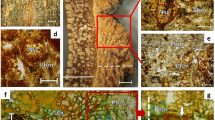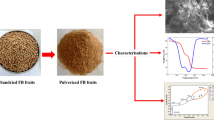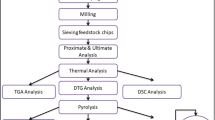Abstract
The objective of this study was to characterize the tree bark of Araucaria angustifolia, for estimate the energy potential of this biomass as a source of renewable energy and products from biorefineries. Studies have been carried out using thermal analysis (TGA-DTA), X-ray diffraction (XRD), scanning electron microscopy (SEM) and dispersive energy spectroscopy (EDS) for thermochemical and morphological analysis. Through thermal analysis, it is possible to observe in A. angustifolia the thermal effects in the presence of air and nitrogen for a dry sample and its phases in view of the effects of temperature and mass loss. A calorific value measured around 12.23MJ/Kg was also seen, being able to consider this product as an alternative energy source and products such as maltol were identified indicating that substances from biorefineries are present in this biomass.






Similar content being viewed by others
REFERENCES
Survey of Energy Resources/World Energy Council, London: WEC, 2013, p. 468.
Atlas of Electric Energy in Brazil/National Electric Energy Agency, Brasilia: Aneel, 2008, p. 236.
Castello, M.L., Dweck, J., and Aranda, D.A.G., J. Therm. Anal. Calorim., 2008, vol. 105, p. 737.
Van Meerbeek, K., Muys, B., and Hermy, M., Renew. Sust. Energ. Rev., 2019, vol. 102, p. 139.
Liu, H., Hong, R., Xiang, C., Wang, H., Li, Y., Xu, G., and Zhu, K., Process. Saf. Environ., 2020, vol. 141, p. 167.
Kung, K.S., Thengane, S.K., Lim, C.J., Sokhansanj, S., and Ghoniem, A.F., Energ. Convers. Manage., 2020, vol. 218, p. 112924.
Ngo, H.C., Chen, W.H., Singh, Y., and Gan, Y.Y., Chen, CY., and Show, P.L., Energ. Convers. Manage., 2020, vol. 209, p. 112634.
Chen, W.H., Eng, C.F., Lin, Y.Y., and Bach, Q.V., Energ. Convers. Manage., 2020, vol. 221, p. 113165.
Sobek, S. and Werle, S., Fuel., 2020, vol. 261, p. 116459.
Font, R. and Willians, P.T., Thermo. Acta, 1995, vol. 250, p. 109.
Wang, T., Liu, T., Ma, T., Li, L., Wang, Q., and Guo, C., Prog. Org. Coat., 2018.
Bhalla, A., Bansal, N., Kumar, S., Bischoff, K.M., and Sani, R.K., Biores. Technol., 2013, vol. 128, p. 751.
Ding, S., Biophys. J., 2010, vol. 98, no. 3, p. 210.
Sakulkit, P., Palamanit, A., Dejchanchaiwong, R., and Reubroycharoen, P., J. Environ. Chem. Eng., 2020, p. 104561.
Wang, K., Zhang, H., Chu, S., and Zha, Z., Chinese J. Chem. Eng., 2020, vol. 29, p. 375.
Peralta, R.M., Koehnlein, E.A., Oliveira, R.F., Correa, V.G., Correa, R.C.G., Bertonha, L., and Ferreira, I.C.F.R., Trends Food. Sci. Tech., 2016, vol. 54, p. 85.
Klein, R.M., Sellowia, 1960, vol. 12, p. 17.
Carvalho, P.E.R. and Colombo, EMBRAPA-CNPF, 1994, p. 640.
Huber, G.W., Iborra, S., and Corma, A., Chem. Rev., 2006, vol. 106, p. 4044.
Yang, H., Yan, R., Chen, H., Lee, D.H., and Zheng, C., Fuel., 2007, vol. 86, p. 1781.
Wang, C., Deng, X., Xiang, W., and Yan, W., Biomass. Bioenerg., 2020, vol. 134, p. 105467.
Kumar, A., Bhattacharya, T., Mozammil Hasnain, S.M., Kumar Nayak, A., and Hasnain, M.S., Mater. Sci. Energ. Technol., 2020, vol. 3, p. 905.
Kardas, D., Hercel, P., Polesek-Karczewska, S., and Wardach-Swiecicka, I., Energy, 2019, vol. 189, p. 116159.
Venkateswara Rao, R., Venkateswarulu, P., Kasipathi, C., and SivaJyothi, S., Appl. Radiat. Isotopes, 2013, vol. 82, p. 211.
Chen, J., Wu, L., and Wu, J., Chinese Chem. Lett., 2020, vol. 31, p. 2993.
Lindsay, W.L., Chemical Balances in Soils, New York: Wiley–Interscience, 1979, p. 499.
Bouain, N., Krouk, G., Lacombe, B., and Rouached, H., Trends Plant. Sci., 2019, vol. 24, p. 542.
Krapp, A., Curr. Opin. Plant. Biol., 2015, vol. 25, p. 115.
Physiology and Determination of Crop Yield, Boote, K.J., Bennett, J.M., Sinclair, T.R., and Paulsen, G. M., Eds., Madison: ASA/CSSA/SSSA, 1994, ch. 11A, p. 285.
Chunmei, X., Liping, C., Song, C., Guang, C., Danying, W., and Xiufu, Z., Rice. Sci., 2020, vol. 27, no. 2, p. 162.
Yan, G., Nikolic, M., Ye, M., Xiao, Z., and Liang, Y., J. Integr. Agric., 2018, vol. 17, no. 10, p. 2138.
Vadstrup, M. and Madsen, T.V., Freshwat. Biol., 1995, vol. 34, p. 411.
Hopkins, W.G., Introduction to Plant Physiology, New York: Wiley, 2000, 2nd ed., p. 512.
Silverstein, R.M., Bassler, G.C., and Morrill, T.C., Spectrometric Identification of Organic Compounds, New York: Wiley, 1991, 5th ed., ch. 3, p. 71.
Cardell, C. and Guerra, I., Trend. Anal. Chem., 2016, vol. 77, p. 156.
ACKNOWLEDGMENTS
The authors would like to gratefully acknowledge the São Paulo Research Foundation (FAPESP) (process no: 2018/03138-7) and Coordination for the Improvement of Higher Education Personnel (CAPES) for the financial support, São Paulo State University (UNESP Sorocaba- ICTS) for the opportunity to develop the project, and the Bioenergy, Biofuels, Climate and Effluents Group (BBCE).
Author information
Authors and Affiliations
Corresponding author
Ethics declarations
The authors declare that they have no conflicts of interest.
About this article
Cite this article
Peres, C.B., Maia, A.A., Guandique, M.E. et al. Biorefinery Product and Energy Potential of Araucária angustifolia bark (BERTOL.) O. Kuntze. Solid Fuel Chem. 56, 59–66 (2022). https://doi.org/10.3103/S0361521922010050
Received:
Revised:
Accepted:
Published:
Issue Date:
DOI: https://doi.org/10.3103/S0361521922010050




